
Gelderland, also known as Guelders in English, is a province of the Netherlands, occupying the centre-east of the country. With a total area of 5,136 km2 (1,983 sq mi) of which 173 km2 (67 sq mi) is water, it is the largest province of the Netherlands by land area, and second by total area. Gelderland shares borders with six other provinces and the German state of North Rhine-Westphalia.

Boekelo is a village in the municipality of Enschede in the eastern Netherlands, the population is estimated at approximately 2,500. It is located just west of Usselo. The village is known for the Military Boekelo Enschede, an international equestrian event. It is also known for the salt industry, since 1919 located south of the village. This was a reason for the then well-known Bad Boekelo to have a salt water wave pool. After the opening of the Twentekanaal the factory of the Koninklijke Nederlandse Zoutindustrie was moved to Hengelo; currently it is called Nouryon Industrial Chemicals.

The Hollandsche IJzeren Spoorweg-Maatschappij or HSM was the first railway company in the Netherlands founded on 8 August 1837 as a private company, starting operation in 1839 with a line between Amsterdam and Haarlem. The company remained operational until 1938, when it merged with the Maatschappij tot Exploitatie van Staatsspoorwegen (SS) to form the Nederlandse Spoorwegen (NS).
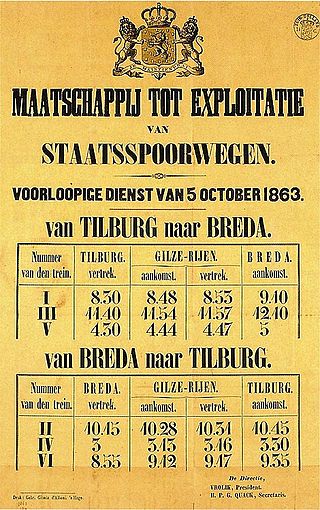
The Maatschappij tot Exploitatie van Staatsspoorwegen or SS was a private railroad founded to use the government funded railways. The company existed until 1938, when it formally merged with the Hollandsche IJzeren Spoorweg-Maatschappij (HSM) to form the Nederlandse Spoorwegen. The SS was, along with the HSM, the largest railroad company in the Netherlands.

The history of rail transport in the Netherlands is generally considered to have begun on September 20, 1839, when the first train, drawn by De Arend, successfully made the 16 km (9.9 mi) trip from Amsterdam to Haarlem. However, the first plan for a railroad in the Netherlands was launched only shortly after the first railroad opened in Britain.
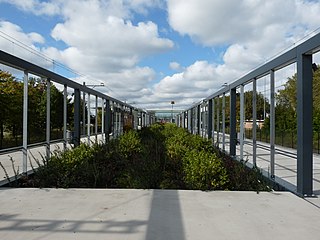
Maassluis Centrum, formerly Maassluis, is a metro station in Maassluis, The Netherlands.

Enschede is the main railway station in Enschede, Netherlands. The station opened on 1 July 1866 and is on the Zutphen–Glanerbeek railway. Between the late 1970s and 2001, the passenger service to Germany stopped. The connection to Münster was reopened in 2001. There is no connection allowing the German trains to run any further into Overijssel; however there was before the line closed.
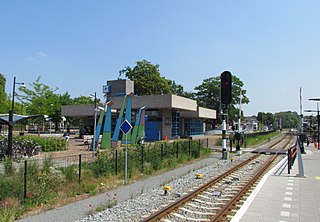
Doetinchem is a railway station located in Doetinchem, Netherlands. The station was opened on 15 July 1885 and is located on the Winterswijk–Zevenaar railway. The station is operated by Arriva and Breng. In Doetinchem there is also Doetinchem De Huet railway station to the west of this station. From 1885 to 1937, it was also the start of the branch to Ruurlo. From Doetinchem station it is a 10-minute walk north to the town centre. In a Railpro survey in 2005, there were approximately 3590 passengers per day using Doetinchem station.

Martenshoek is an unstaffed railway station in Martenshoek in the Netherlands. The station opened on 1 Jan 1905 and is located on the Harlingen–Nieuweschans railway between Groningen and Nieuweschans. The services are operated by Arriva.

Winterswijk is a railway station in Winterswijk, Netherlands. The station opened on 24 June 1878 and is located on the Zutphen–Winterswijk railway and the Winterswijk–Zevenaar railway. The train services are operated by Arriva.

The Winterswijk – Zevenaar railway is a 49-kilometre-long (30 mi) Dutch regional railway line, that connects Arnhem and Zevenaar with Doetinchem and Winterswijk.

The NS 1600 was a series of steam engines of the Dutch national railways, Nederlandse Spoorwegen (NS), and its predecessors Maatschappij tot Exploitatie van Staatsspoorwegen (SS), Hollandsche IJzeren Spoorweg-Maatschappij (HSM) and Nederlandsche Rhijnspoorweg-Maatschappij (NRS).
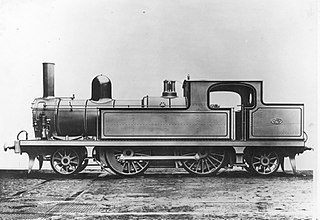
The NS 5300 class were the first of this class in The Netherlands, in fact the NRS employed the first passenger service tender locomotives with this type. The Westinghouse brake system was a first for the NRS; the additional hand brake was common. To obtain a stable ride at high speeds, inside cylinders were employed. The firebox was situated between the coupled axles. The front and rear axles were of the Webb type, already employed by the London North Western Railway. The radial axle boxes were produced with very fine tolerances. Rubber bumpers were employed to move the axle back into position.
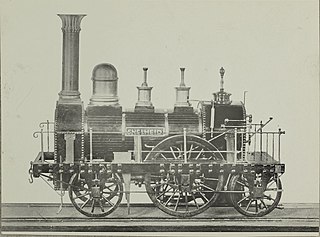
The Snelheid was the name of the first locomotive in the Netherlands, which, together with the Arend, pulled the first train between Amsterdam and Haarlem.

The NS 3300 was a series of goods steam locomotives of the Dutch Railways (NS) and its predecessor Hollandsche IJzeren Spoorweg-Maatschappij (HSM).

The NS 7600 was a series of tank engines of the Dutch Railways (NS) and its predecessor Hollandsche IJzeren Spoorweg-Maatschappij (HSM) and Haarlem-Zandvoort Spoorweg Maatschappij (HZSM).

The NS 7100 was a series of tank engines of the Dutch Railways (NS) and its predecessors Maatschappij tot Exploitatie van Staatsspoorwegen (SS), Hollandsche IJzeren Spoorweg-Maatschappij (HSM) and Noord-Friesche Locaalspoorweg-Maatschappij (NFLS).

The NS 7700 was a series of tank engines of the Dutch Railways (NS) and its predecessor the Hollandsche IJzeren Spoorweg-Maatschappij (HSM).

The NS 1900 was a series of express train steam locomotives of the Dutch Railways (NS) and its predecessor Hollandsche IJzeren Spoorweg-Maatschappij (HSM).





















